CERN, the European Organization for Nuclear Research, is home to the largest particle collider and detector in the world. The Large Hadron Collider is 17 miles (27 km) in circumference and crosses the Swiss-French border four times in a tunnel as deep as 574 ft (175m). And the ATLAS detector is 150 ft (46m) long, 82ft (25m) in diameter and weighs 7,000 tonnes, similar to the weight of the Eiffel Tower.
Besides being a center for high-energy physics research, CERN also has an excellent visitor center with scientist-guided tours of the Synchrocyclotron, CERN’s first accelerator, and the ATLAS control room.
We spent the entirety of our last full day in Switzerland at CERN and really enjoyed our visit. The complex is a half-hour bus ride outside of Geneva—we were the first to arrive in the morning and also were close to the last to leave. We were able to join both tours, and spent the rest of the time studying the interesting and educational exhibits in the visitor center.
Below are highlights from July 9, 2022. Click any image for a larger view, or click the position to view the location on a map. And a map with our most recent log entries always is available at mvdirona.com/maps.
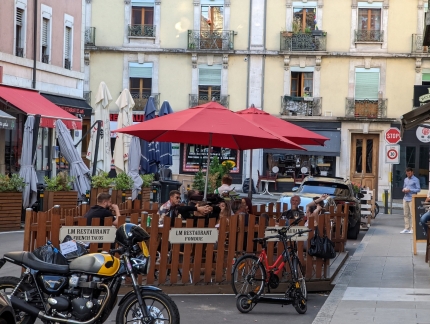 |
Late Night
Position: 46°12.67’N, 6°8.73’E
As we left our hotel shortly after 7am, we passed a large group drinking wine and beer at the LM Boulangerie. That’s a pretty late night.
|
 |
Geneva Station
Position: 46°12.59’N, 6°8.49’E
At the Geneva train station to catch a streetcar to CERN, the European Organization for Nuclear Research (acronym derived from the French term Conseil Europeen pour la Recherche Nucleaire).
|
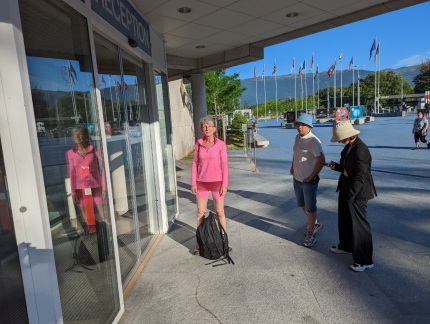 |
CERN
Position: 46°13.99’N, 6°3.34’E
We arrived at CERN just before 8am and are first in line. The reason we arrived so early is to sign up for their tours, which fill up quickly. Sign-up can only be done in person the day of the tour.
|
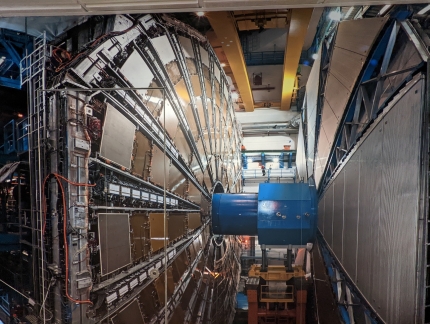 |
Atlas Detector
Position: 46°13.97’N, 6°3.34’E
Photograph at CERN of the ATLAS detector, the largest volume detector ever constructed for a particle collider at 150 ft (46m) long and 82ft (25m) in diameter. The detector weighs 7,000 tonnes, similar to the weight of the Eiffel Tower, and is installed 328ft (100m) below ground. For scale, a person is just visible at center, standing on a walkway beyond the blue central section (click image for a larger view).
|
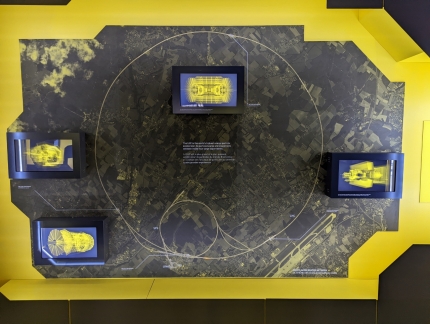 |
Large Hadron Collider
Position: 46°13.96’N, 6°3.34’E
The large circle in the picture shows the footprint of the Large Hadron Collider (LHC), first used at CERN in 2008. It’s the world’s largest at 17 miles (27 km) in circumference and in a tunnel as deep as 574 ft (175m). For scale, the Geneva airport is at bottom right.
|
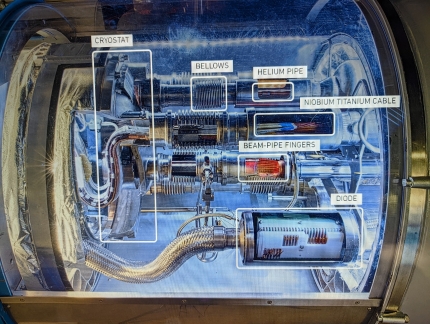 |
Magnet Interconnection
Position: 46°13.96’N, 6°3.34’E
The Large Hadron Collider uses superconducting electromagnets to guide two two high-energy particle beams in opposite directions at close to the speed of light before they are made to collide. This cutaway shows the interconnection between two superconducting magnets. The magnets sit inside a cryostat and are cooled by liquid helium, brought in through the helium pipe, to slightly above absolute zero (-460°F; -273°C), or around 572°F (300°C) below the ambient temperature in the tunnel. The bellows allow for expansion and contraction. The nobium-titanium cable brings power to the magnets, the beam pipe is where the particle beams travel and the beam-pipe fingers maintain an electrical connection between the magnets while they cool during colliding. The diodes are an emergency measure to drain current from the system should the magnets stop working.
|
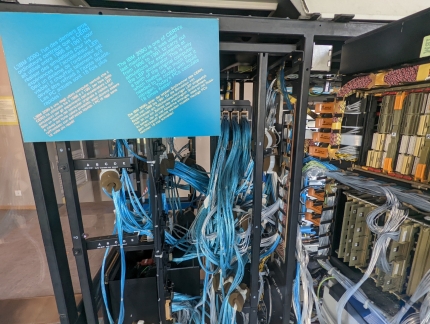 |
IBM 3090
Position: 46°13.95’N, 6°3.30’E
The IBM 3090 was one of CERN’s last mainframes, used for experiments from 1986 to 1991. The system was water-cooled to keep temperatures under control.
|
 |
Synchrocyclotron Tour
Position: 46°13.98’N, 6°3.16’E
The CERN tours are conducted by resident scientists who know the technology in amazing detail. Here our guide is discussing important events in CERN’s history on a tour of the Synchrocyclotron, CERN’s first accelerator.
|
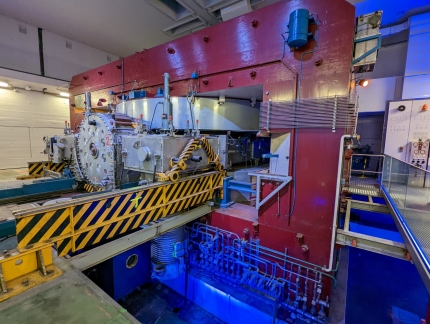 |
Synchrocyclotron
Position: 46°13.98’N, 6°3.16’E
The Synchrocyclotron was CERN’s first accelerator, in use from 1957 through 1990. The large red-painted section is the accelerator’s magnet. Part of the tour included an excellent animation showing how the accelerator worked, using animations projected onto the accelerator’s surfaces.
|
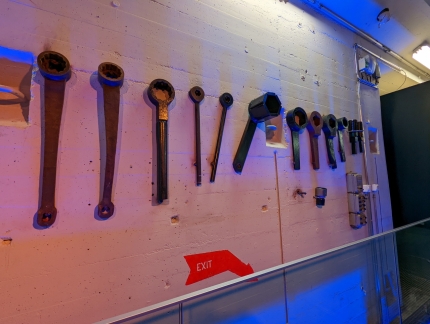 |
Tools
Position: 46°13.98’N, 6°3.16’E
These surprisingly low-tech tools at the Synchrocyclotron were used to tighten the accelerator’s red magnet.
|
 |
Pizza d’Oro
Position: 46°13.74’N, 6°4.26’E
A great pizza lunch at Pizza d’Oro in Meyrin, near CERN.
|
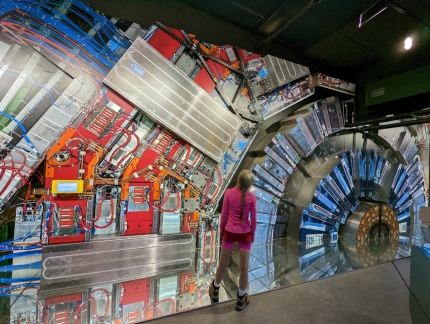 |
CMS Detector
Position: 46°13.95’N, 6°3.34’E
Jennifer studying a life-sized model of the Compact Muon Solenoid (or CMS) detector, a general-purpose detector that sits at one of the four collision points within the Large Hadron Collider. The technology is impressive, but also quite beautiful.
|
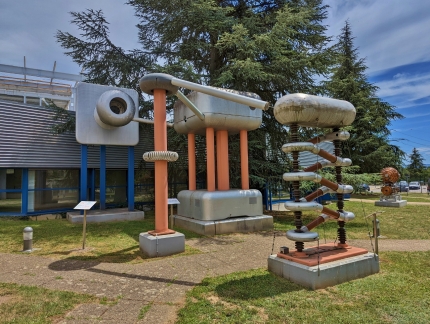 |
Microcosm Garden
Position: 46°13.97’N, 6°3.33’E
The Microcosm Garden displays components of past CERN experiments, looking much like modern sculptures.
|
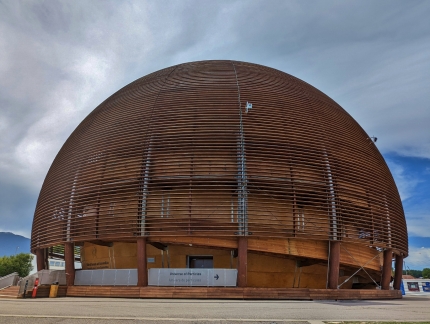 |
Globe of Science and Innovation
Position: 46°14.02’N, 6°3.32’E
The Globe of Science and Innovation event and visitor’s center originally was built for the sixth Swiss National Exposition, Expo.02, that took place in Neuchatel, Switzerland.
|
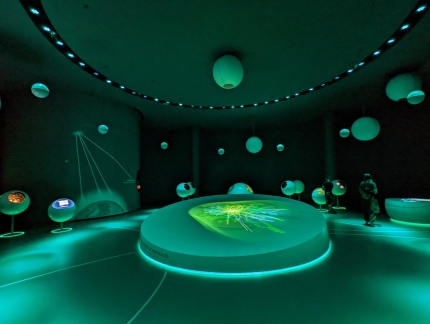 |
Universe of Particles
Position: 46°14.05’N, 6°3.35’E
The Universe of Particles exhibit inside the Globe of Science and Innovation covers contemporary physics problems that currently are under research at CERN.
|
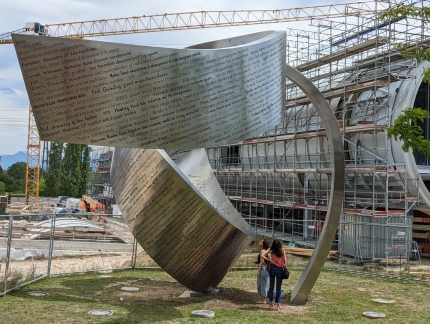 |
Wandering the Immeasurable
Position: 46°14.02’N, 6°3.35’E
The striking sculpture Wandering the Immeasurable, by Canadian artist Gayle Hermick, outside the Globe of Science and Innovation. The work symbolizes knowledge passing between people with the outer layer showing scientific discoveries, and the inner layer displaying equations and symbols representing the math behind the science.
|
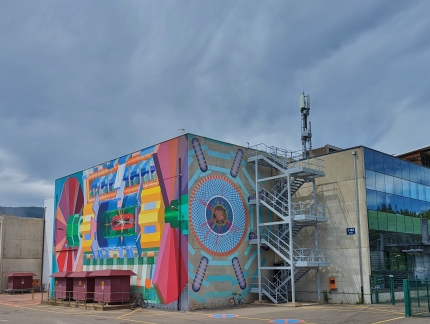 |
ATLAS Mural
Position: 46°14.09’N, 6°3.37’E
Mural of ATLAS by American artist Josef Kristofoletti, painted on the side of the building containing its control room. The mural is three stories tall yet still only one-third the size of the actual detector. The mural accurately depicts the detector and is intended to be the next best thing to seeing ATLAS itself, which is closed to visitors.
|
 |
ATLAS Control Room Tour
Position: 46°13.83’N, 6°3.93’E
We were able, just barely, to fit in both CERN tours in one day. Here a graduate student, who was only a few hours minutes ago working in the ATLAS control room, is taking us on a tour of that facility. She was wonderfully enthusiastic and knowledgeable about CERN and its technology.
|
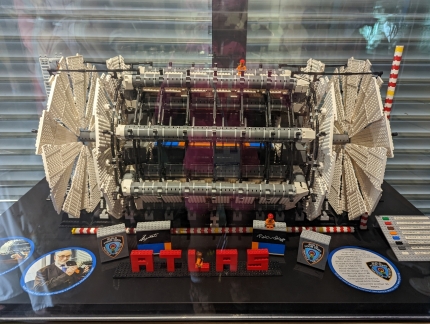 |
Atlas in Lego
Position: 46°14.13’N, 6°3.35’E
A model of the ATLAS detector built of lego.
|
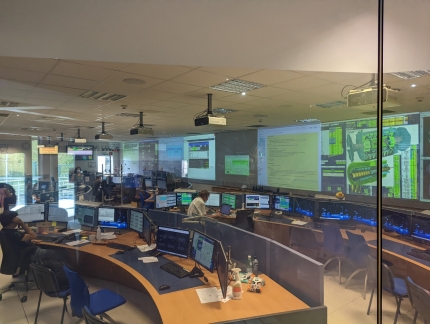 |
ATLAS Control Room
Position: 46°14.13’N, 6°3.35’E
The ATLAS control room, where experiments and the state of the detector are monitored. The tour also included a 3D movie explaining how accelerators work.
|
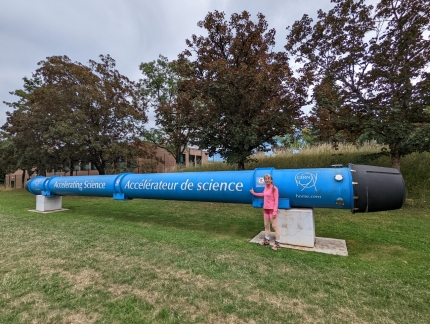 |
LHC Section
Position: 46°14.02’N, 6°3.24’E
Lifesize model of a section of the Large Hadron Collider.
|
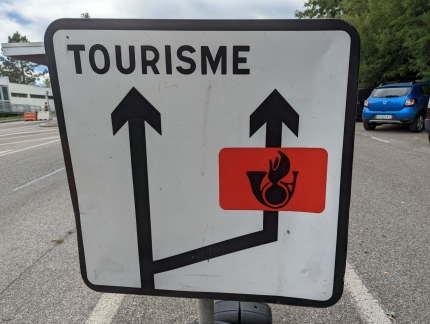 |
Border Crossing
Position: 46°14.10’N, 6°3.03’E
The CERN grounds are on the Swiss-French border and since we were so close, we decided to make a quick walk into France. This traffic sign at the border seems to be directing tourist to the left and people with trumpets on fire to the right :-).
|
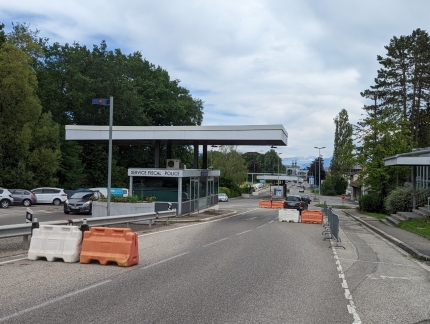 |
In France
Position: 46°14.11’N, 6°2.95’E
Looking back to Switzerland from France. Both are Schengen states, but Switzerland in not part of the EU customs zone, so we were surprised not to see any border crossing guards.
|
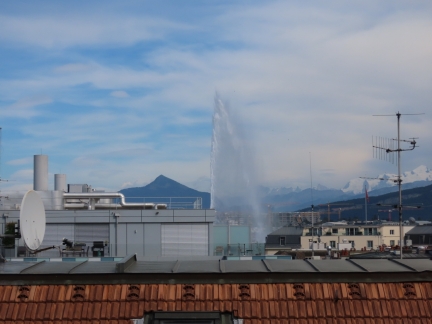 |
Jet d’Eau
Position: 46°12.67’N, 6°8.74’E
The 460-ft (140m) Jet d’Eau (water jet), in Lake Geneva, viewed from our hotel room. It wasn’t running yesterday due to high winds and we were disappointed not to see it. The water jet is back running at its normal amazing height today
|
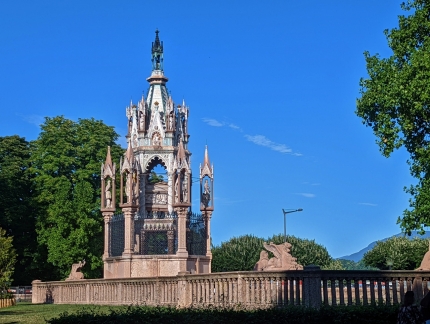 |
Brunswick Monument
Position: 46°12.50’N, 6°8.89’E
The Brunswick Monument, completed in 1879, commemorates Charles II, Duke of Brunswick, who bequeathed his fortune to the city of Geneva.
|
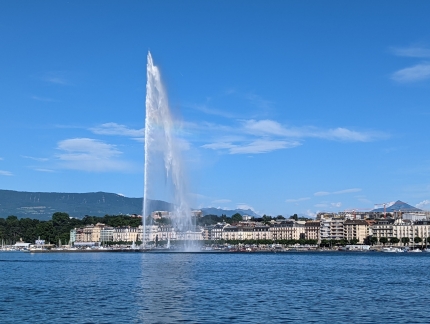 |
Full Jet d’Eau
Position: 46°12.48’N, 6°8.94’E
Full view to the 460-ft (140m) Jet d’Eau (water jet) in Lake Geneva. The first Jet d’Eau was built in 1886 to relieve excess pressure at a nearby hydraulic plant and became a symbol of the city. The current incarnation was installed in 1951.
|
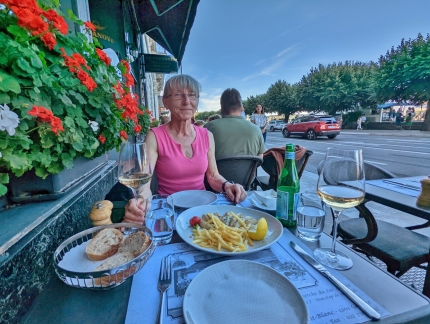 |
Le Casanova
Position: 46°12.44’N, 6°8.88’E
A wonderful meal street-side at Le Casanova in Geneva. We had their specialty, perch fillets from Lake Geneva.
|
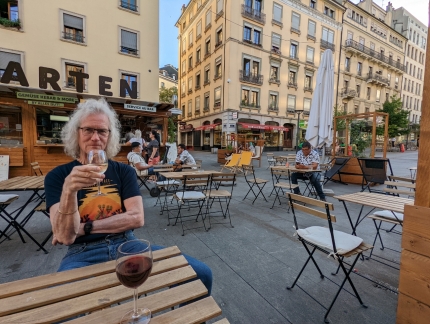 |
Rue du Mont-Blanc
Position: 46°12.53’N, 6°8.66’E
An evening drink in the pedestrian mall Rue du Mont-Blanc.
|
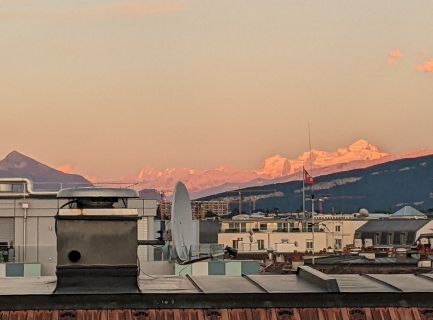 |
Dusk
Position: 46°12.67’N, 6°8.75’E
A final dusk view in Switzerland, of Mont Blanc in France, before we fly home early tomorrow morning. We had a fabulous time in Switzerland and would definitely return, perhaps in the winter.
|
 |
Click the travel log icon on the left to see these locations on a map. And a map of our most recent log entries always is available at mvdirona.com/maps. |

All very interesting and beautiful photos, thank you very much.
Thanks for the feedback Mario. CERN has done a great job of making their technology accessible to the public and we really enjoyed our visit.
Jennifer